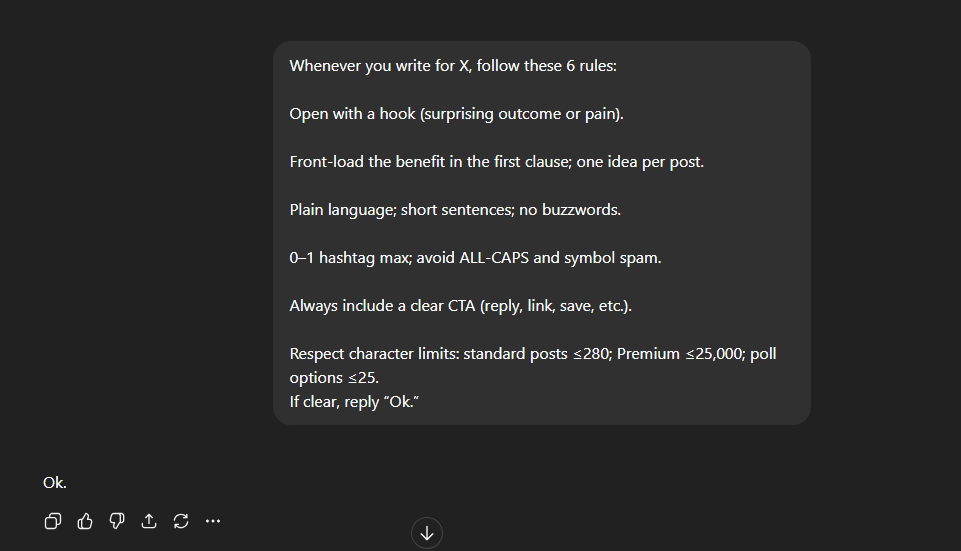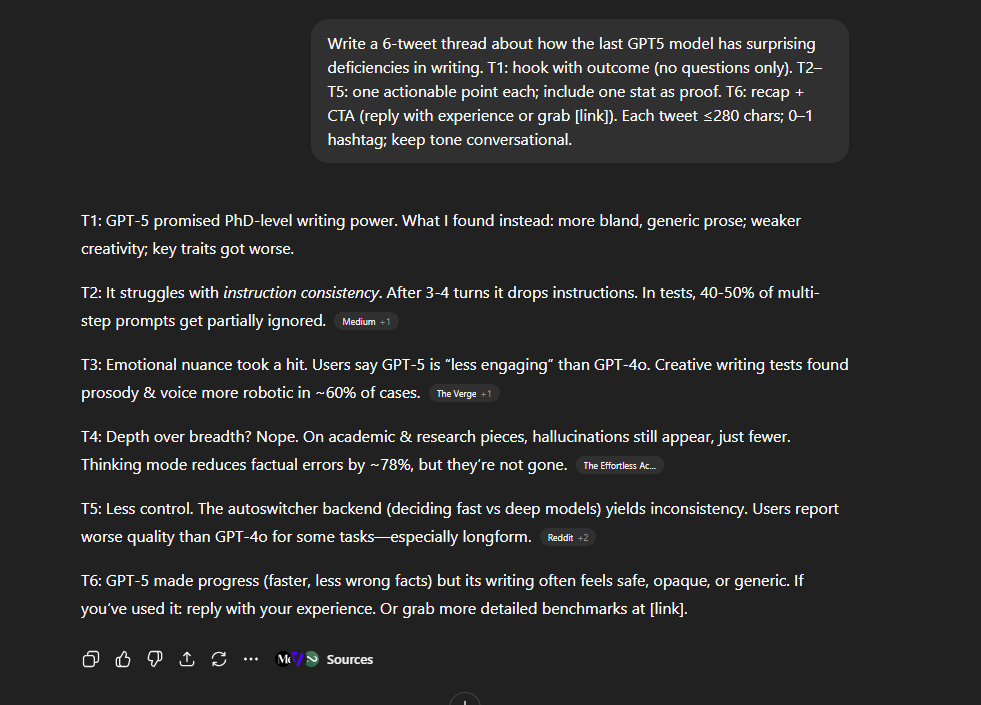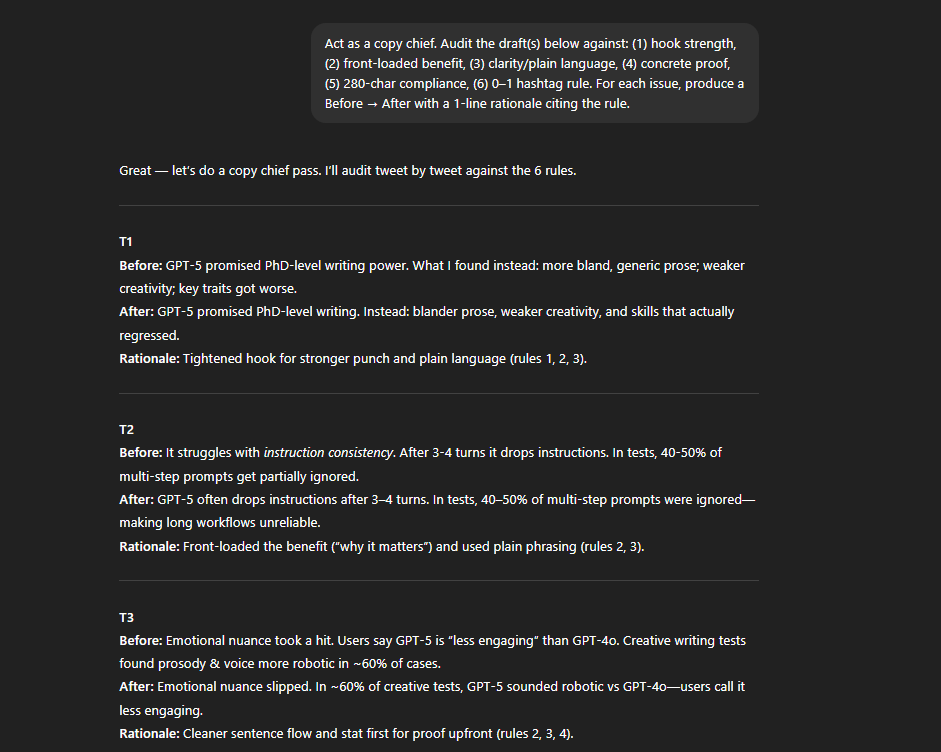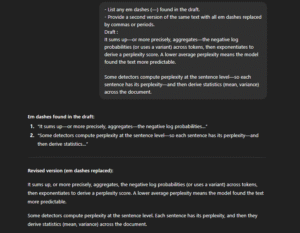On X, you get one screen and a heartbeat to earn a swipe-stop.
ChatGPT can absolutely help you ship that kind of post –if your prompt behaves like a creative brief.
Here, we’ll walk you through a step-by-step prompting process that draft batches by angle (benefit, pain, proof, curiosity), and refine with a quick copy-chief pass.
Is ChatGPT really good at writing on X?
Short answer: yes—if you treat it like a brief-driven assistant and bake X’s constraints into your prompts.
ChatGPT can reliably generate angle-diverse post ideas, hooks, and thread starters when the brief is concrete.
What “good” means on X is different from other channels. You’re working with microcontent: text that must make sense out of context, surface value immediately, and invite lightweight interaction (replies, quote-posts).
Where ChatGPT genuinely helps on X
- Rapid ideation and variety. ChatGPT show repeatable success in producing 8–10 distinct angles per topic (benefit-first, pain-first, proof-led, curiosity), which lets you test quickly without rewriting from scratch.
- Thread scaffolding and repurposing. ChatGPT can commonly convert longer content into 5–7 tweet threads with a hook, one actionable point per tweet, and a closer/CTA—precisely the structure that travels in the feed.
Platform realities you must encode
No amount of clever wording beats the rules of the platform—your prompts should hard-code them. On standard accounts, posts are ≤280 characters; Premium allows long posts up to 25,000 characters (useful for mini-guides, then quote-post a 280-character TL;DR). Polls allow 2–4 options, each ≤25 characters, and that option text doesn’t count against the 280 in your post copy. When these limits are made explicit in the prompt (“return 8 variants ≤280 chars… options ≤25 chars”), output quality jumps and compliance issues drop.
What to watch out for
- Generic voice without assets. if you don’t feed proof (stats, named examples, quotes) and audience language, ChatGPT will default to boilerplate. The fix is simple: paste a few VoC snippets and one concrete proof into the prompt and require the model to reuse them.
- Over-formatting or hashtag clutter. Keep posts conversational and minimal on hashtags—often zero or one. ChatGPT loves to add too much of them.
- Threads without a spine. Threads flop when they read like stitched tweets. The better prompt patterns ask for a consistent outline (T1 outcome-hook; T2–T5 one takeaway each; T6 recap + CTA).
Step-by-Step ChatGPT Prompts for X (Twitter)
X’s feed rewards concise, high-signal microcopy. Your prompts should act like a tight creative brief.
a) Persona — assign the voice and the job

Why: A persona prompt clarifies who’s speaking, who’s listening, and what language to mirror.
You are [Your Name], an X social copywriter in [your field]. Your goal: deliver quick, valuable insights for [audience] about [topic]. If the persona and goal are clear, reply “Ok.”
This “Ok” handshake is a simple way to ensure the model registers the role before drafting. It’s common in practitioner prompt lists.
b) Style guidelines — make the rules explicit (and platform-true)

Why: Encode voice traits, tone, and hard platform limits directly in your style block so the model doesn’t wander. Include constraints like ≤280 characters (or ≤25,000 for Premium long posts) and poll options ≤25 characters.
Whenever you write for X, follow these 6 rules:
- Open with a hook (surprising outcome or pain).
- Front-load the benefit in the first clause; one idea per post.
- Plain language; short sentences; no buzzwords.
- 0–1 hashtag max; avoid ALL-CAPS and symbol spam.
- Always include a clear CTA (reply, link, save, etc.).
- Respect character limits: standard posts ≤280; Premium ≤25,000; poll options ≤25.
If clear, reply “Ok.”
c) Writing — batch by angle, respect formats

Now it’s time to write. Generate angle-diverse batches and multiple formats. Ask for several distinct variations per task—benefit, pain, proof, curiosity—so you can test without rewriting.
1) Single posts (standard 280 chars)
Write 8 X posts (each ≤280 chars) for [audience] to [goal]. Mix 2 benefit-first, 2 pain-first, 2 proof-led (include a specific number), 2 curiosity (no clickbait). =
2) Polls (options ≤25 chars)
Prompt (poll + follow-up)
Draft a poll post on [topic]. Provide 3–4 options ≤25 characters and a follow-up post that discusses results and invites replies (“Tell us why you voted…”). Include a note on potential bias.
3) Threads (5–7 tweets with a spine)
Write a 6-tweet thread about [your ideas]. T1: hook with outcome (no questions only). T2–T5: one actionable point each; include one stat as proof. T6: recap + CTA (reply with experience or grab [link]). Each tweet ≤280 chars; 0–1 hashtag; keep tone conversational.
4) Long posts (Premium)
If you (or your client) has Premium, long posts can be mini-guides—but ship with a single-tweet TL;DR for quote-posting.
Create a long post (≤25,000 chars) with section breaks (—) and one concrete stat per section based on this outline [your outline]. End with a TL;DR ≤280 chars we can post separately as a quote. Keep voice rules; avoid hashtag clutter.
5) Repurposing (article → thread)
Prompt (repurpose with proof)
Turn the article below into a 7-tweet thread: extract 5 key takeaways, add 1 stat or named example as proof, end with a CTA. Each tweet ≤280 chars. Label tweets T1–T7.
Context:"""[paste article or notes]"""
d) Refining — tighten, de-genericize, and certify

Great first drafts still need editing.
Prompt (copy-chief audit + before/after pairs)
Act as a copy chief. Audit the draft(s) below against: (1) hook strength, (2) front-loaded benefit, (3) clarity/plain language, (4) concrete proof, (5) 280-char compliance, (6) 0–1 hashtag rule. For each issue, produce a Before → After with a 1-line rationale citing the rule.
Prompt (less predictable, pattern interrupt)
Rewrite Version A with a less predictable structure. Keep meaning; alter rhythm using short + staccato lines and a pattern-interrupt (contrast, question fragment, or unexpected stat). ≤280 chars.
Prompt (make it concrete)
Replace abstract claims with specifics (numbers, named examples, “from → to” statements). Keep one idea per post and a single CTA. ≤280 chars.
Prompt (character & hashtag check, auto-fix)
Verify length (≤280) and 0–1 hashtag; if over, tighten by removing filler and keeping the hook + proof + CTA intact. Return a table: Old length | New length | What changed.
Prompt (thread polish + reply prompts)
For this thread, propose reply prompts for T2–T3 that invite stories or tips without engagement bait, and strengthen the closer CTA with a specific next step. Keep each tweet ≤280 and the tone conversational.
One-Shot ChatGPT Prompts for X (Twitter)
Sometimes you need a single, self-contained prompt that reliably returns on-brand, platform-compliant posts you can schedule.
The One-Shot Blueprint (use this skeleton for any task)
Role: You are a social copywriter for [brand].
Goal: [metric: clicks, replies, follows].
Audience: [segment + pain/desire].
Voice/Tone: [3 traits]; conversational and concise.
Platform Rules: ≤280 characters per post (unless I say “Premium long post”); avoid hashtags in body copy; include a clear CTA; no ALL-CAPS.
Assets (don’t invent): “”“[benefit, stat, VoC phrase, link label]”“”.
Output Format: [table/sections]; require angle labels (Benefit/Pain/Proof/Curiosity).
Self-check: List 5 bullets confirming: benefit first, CTA present, ≤280 chars, no body hashtags, conversational tone.
A) Single-Post Batch (ready to schedule)
“Write 10 X posts (≤280 chars) for [audience] to [goal]. Mix: 3 Benefit-first, 3 Pain-first, 2 Proof-led (include a specific number), 2 Curiosity (no clickbait). Rules: follow platform rules above (avoid hashtags in body, clear CTA). Assets: ‘’’[benefit, stat, VoC phrase, link label]’’’. Output: table with columns Post | Angle | CTA | Proof used | Rationale.”
B) Poll + Follow-Up (lightweight interaction)
“Draft an X poll on [topic] to learn [insight]. Rules: neutral question; 3–4 options ≤25 chars each (non-leading). Add: a follow-up post (≤280 chars) to discuss results and invite replies. Note any wording bias you see.”
C) 6-Post Thread (story arc, not stitched tweets)
“Outline a 6-post thread: T1 outcome-driven hook; T2–T5 one actionable takeaway each (micro-example included); T6 recap + CTA (reply with [prompt] or grab [link]). Then draft each post ≤280 chars, conversational, no hashtags in body. Include suggested alt-text if an image would help.”
D) Premium Long Post (+ TL;DR)
When to use: If you have X Premium, you can publish “long posts” up to 25,000 characters. Use them as mini-guides, then quote-post a ≤280-character TL;DR for reach. State the limit explicitly so the model doesn’t ramble or truncate.
“Write a Premium long post (≤25,000 chars) as a mini-guide with divider lines (—) between sections. Use plain language and include one stat per section. Finish with a TL;DR ≤280 chars we can quote-post.”
E) Repurposer (article → thread)
Why this works: Prompt libraries routinely include “repurpose longform to X” patterns—great for creators with blogs, reports, or podcasts. Keep the per-post limit front and center.
“Turn this article into a 7-post X thread: extract 5 key takeaways, add 1 stat as proof, end with a CTA. Keep each post ≤280 chars and conversational. Assets: ‘’’[paste article or notes]’’’.”
F) Bio Refresh + Pin-Worthy Post
“Rewrite our X bio in ≤160 characters with one proof element (number, win, or named customer). Propose one pin-worthy post (≤280 chars) that sums up our value proposition with a clear CTA.”
(Note: Bio character count is kept short by convention and tool UIs; enforce your own limit.)






